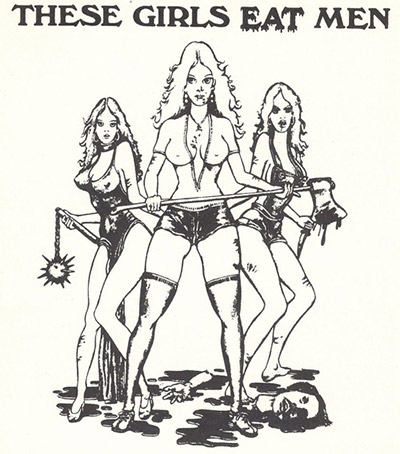blood

Menstrual synchrony was first demonstrated in a 1971 paper published in Nature by Martha McClintock. […]
she asked 135 college girls living in dorms to recall their period start dates at three times throughout the academic year. She found that close-friend groups had periods significantly closer together in April (later in the year) compared with October: lessening from an average of 6.4 to 4.6 days apart.
The phenomenon was dubbed “the McClintock effect” and is widely held as the first example of pheromones — unconscious chemical signals that influence behavior and physiology — among humans. […] Many subsequent researchers went on to reproduce the results from McClintock’s original experiment in people, rats, hamsters and chimpanzees.
But a cohort of studies that found no evidence for menstrual synchrony began to grow, too. […]
In 1992 H. Clyde Wilson […] re-analyzed McClintock’s first experiment, along with a few others that used a similar design. He found that all had inflated the difference between period start dates at the beginning of their studies […] their model of two pheromones — one that pulls ovulation forward and one that delays it — driving synchrony didn’t work […]
The insurmountable hurdle in all the studies is that women often have persistent cycles of different lengths. As such, they can never truly synchronize, just randomly phase in and out of synchrony over the months as their cycles diverge and converge. […]
But a team of Japanese researchers at Yokohama City University, led by Kazuyuki Shinohara, also found in a series of papers that donor women undergoing these two phases of the menstrual cycle release compounds that when inhaled by other women can significantly impact the frequency in the latter of pulses of luteinizing hormone (LH), which helps control the timing of ovulation and cycle length.
{ Scientific American | Continue reading }
blood, hormones, mystery and paranormal | March 30th, 2024 6:20 am

How do they keep blood flowing during heart transplant?
You’ll receive medication that causes you to sleep (general anesthetic) before the procedure. Your surgeons will connect you to a heart-lung bypass machine to keep oxygen-rich blood flowing throughout your body. This machine does the work of your heart and lungs while they are stopped.
Your surgeon will make an incision in your chest. Your surgeon will separate your chest bone and open your rib cage so that he or she can operate on your heart.
Your surgeon then removes the diseased heart and sews the donor heart into place. He or she then attaches the major blood vessels to the donor heart. The new heart often starts beating when blood flow is restored. Sometimes an electric shock is needed to make the donor heart beat properly.
{ Mayo Clinic | Continue reading }
related { In a First, Man Receives a Heart From a Genetically Altered Pig | NY Times }
quote { Ginny Hogan }
blood, health | January 11th, 2022 11:56 am

Study provides insight into the neurobiology of dying. Investigators performed continuous patient monitoring following Do Not Resuscitate - Comfort Care orders in patients with devastating brain injury to investigate the mechanisms and timing of events in the brain and the circulation during the dying process.
{ ScienceDaily | Continue reading }
Oxygen deprivation results in brain injury. For years, researchers have been studying the underlying processes in animals: within 20 to 40 seconds, the brain enters an ‘energy-saving mode’ - it becomes electrically inactive, and all interneuronal communication ceases. Within a few minutes, the brain’s fuel reserves have become depleted that maintain the uneven distribution of ions between the inside and outside of nerve cells, and the ion gradients start to break down. This breakdown takes the form of a massive wave of electrochemical energy release in the form of heat, which is known as ’spreading depolarization’. More vividly described as a ‘brain tsunami’, this energy loss spreads through the cortex and other areas of the brain, triggering pathophysiological cascades which gradually poison the nerve cells. Importantly, this wave remains reversible up to a certain point in time: nerve cells will recover fully if circulation is restored before this point is reached. However, if circulation remains disrupted, the cells will die. Until now, recordings of electrical brain activity obtained from human subjects have been of limited applicability, and experts have been divided as to the transferability of results from animal-based research. […]
“We were able to show that terminal spreading depolarization is similar in humans and animals. Unfortunately, the research community has been ignoring this essential process of central nervous system injury for decades, all because of the mistaken assumption that it does not occur in humans,” explains Prof. Dreier.
{ EurekAlert | Continue reading }
paint on plaster { Eduardo Paolozzi, Targets, 1948 }
blood, neurosciences | December 2nd, 2018 12:50 pm

With traditional birth control, a woman takes a hormone pill for 21 days to stop her cycle. Then she takes a sugar pill for a week, so she can have what looks like a period.
But Micks says, physiologically this isn’t a real period at all. And it isn’t necessary. “There’s absolutely no medical need to have a period when you’re on contraception,” she says.
So why have women been having all these “fake” periods for decades? “It’s actually a historical thing,” she says.
One of the doctors who helped invent the pill was Catholic. He thought the pope might accept the pill if it looked like women were having periods.
{ NPR | Continue reading }
blood | May 24th, 2016 2:15 pm

Sally Ride’s tampons might be the most-discussed tampons in the world. Before Ride became the first American woman in space, scientists pondered her tampons, weighed them, and NASA’s professional sniffer smelled them—better to take deodorized or non-deodorized?—to make sure they wouldn’t smell too strongly in a confined space capsule. Engineers considered exactly how many she might need for a week in space. (Is 100 the right number?, they famously asked her. No, Ride said. That is not the right number.)
The engineers were trying to be thoughtful, though; reportedly they packed the tampons with their strings connected so that they wouldn’t float away. […]
Before women went into space, there were not only the sadly typical concerns that women would become weepy or unable to function during their periods, but also that the menstrual cycle might somehow break in space. Would the blood come out without gravity to pull it from the womb? Maybe it would all pool up in there, or even flow backward through the fallopian tubes into the abdomen—a frightening condition called retrograde menstruation.
In the end, someone just had to try it and see what happened. And what happened was … nothing much. The uterus is pretty good at expelling its lining sans gravity, it turns out.
{ Phenomena | Continue reading | More: The Conversation }
related { Early Menarche is Associated With Preference for Masculine Male Faces and Younger Preferred Age to Have a First Child }
photo { Eri Morita }
blood, space | April 25th, 2016 1:00 pm

By licking a wound it heals faster — this is not simply popular belief, but scientifically proven. Our saliva consists of water and mucus, among other things, and the mucus plays an important role. It stimulates white blood cells to build a good defense against invaders.
{ Lunatic Laboratories | Continue reading }
Blood is a bodily fluid in humans and other animals that delivers necessary substances such as nutrients and oxygen to the cells and transports metabolic waste products away from those same cells. […] In vertebrates, it is composed of blood cells suspended in blood plasma. Plasma, which constitutes 55% of blood fluid, is mostly water (92% by volume), and contains dissipated proteins, glucose, mineral ions, hormones, carbon dioxide (plasma being the main medium for excretory product transportation), and blood cells themselves. Albumin is the main protein in plasma, and it functions to regulate the colloidal osmotic pressure of blood. The blood cells are mainly red blood cells, white blood cells (also called leukocytes) and platelets. The most abundant cells in vertebrate blood are red blood cells.
{ Wikipedia | Continue reading }
related { A completely new view of how human blood is made has been discovered by scientists, upending conventional dogma from the 1960s. }
photo { Young Kyu Yoo }
blood, health | November 9th, 2015 5:53 am

In a stunning discovery that overturns decades of textbook teaching, researchers at the University of Virginia School of Medicine have determined that the brain is directly connected to the immune system by vessels previously thought not to exist. That such vessels could have escaped detection when the lymphatic system has been so thoroughly mapped throughout the body is surprising on its own, but the true significance of the discovery lies in the effects it could have on the study and treatment of neurological diseases ranging from autism to Alzheimer’s disease to multiple sclerosis.
{ EurekAlert | Continue reading }
unrelated { The benefits of a herpes infection }
blood, brain, health | June 2nd, 2015 1:18 pm

Red blood cells carry oxygen to all the cells and tissues in our body. If we lose a lot of blood in surgery or an accident, we need more of it – fast. Hence the hundreds of millions of people flowing through blood donation centres across the world, and the thousands of vehicles transporting bags of blood to processing centres and hospitals.
It would be straightforward if we all had the same blood. But we don’t. On the surface of every one of our red blood cells, we have up to 342 antigens – molecules capable of triggering the production of specialised proteins called antibodies. It is the presence or absence of particular antigens that determines someone’s blood type. […]
If a particular high-prevalence antigen is missing from your red blood cells, then you are ‘negative’ for that blood group. If you receive blood from a ‘positive’ donor, then your own antibodies may react with the incompatible donor blood cells, triggering a further response from the immune system. These transfusion reactions can be lethal. […]
There are 35 blood group systems, organised according to the genes that carry the information to produce the antigens within each system. The majority of the 342 blood group antigens belong to one of these systems. The Rh system (formerly known as ‘Rhesus’) is the largest, containing 61 antigens.
The most important of these Rh antigens, the D antigen, is quite often missing in Caucasians, of whom around 15 per cent are Rh D negative (more commonly, though inaccurately, known as Rh-negative blood). But Thomas seemed to be lacking all the Rh antigens. If this suspicion proved correct, it would make his blood type Rh null – one of the rarest in the world, and a phenomenal discovery for the hospital haematologists. […] Some 43 people with Rh null blood had been reported worldwide.
{ Mosaic | Continue reading }
blood | October 24th, 2014 3:11 am

Leveraging the insight that periods, while a pain, also bring women together, JWT has created an augmented reality app that combines Chinese consumers’ love of technology, cute characters and selfies into a new branded platform for Sofy sanitary pads.
{ Campaign Asia | Continue reading | Thanks Tim }
asia, blood, marketing, weirdos | October 17th, 2014 12:17 pm

She also learned an old cop trick: If you’re recovering a body in an apartment building, ask every tenant to make coffee — it covers the smell. “Oldest trick in the book,” one officer told her. […]
She began, as all autopsies do, by inserting a needle into the side of each eye to collect fluid — a delicate procedure Melinek perfected after once popping out a cadaver’s glass eyeball. […] Then she removed Booker’s testes, took a samples from each, and put them back in the scrotum. […]
There was the subway jumper at Union Square, for example, whose body was recovered on the tracks of the uptown 4 train with no blood — none at the scene, none in the body itself. She’d never seen anything like it, and only CME Hirsch could explain: The massive trauma to the entire body caused the bone marrow to absorb all the blood. […]
In one case, a man was shot in the chest, but the bullet was found in his liver.
{ NY Post | Continue reading }
photo { Hiroshi Sugimoto }
blood, new york | August 4th, 2014 6:52 am

Vein geometry is just as unique as irises and fingerprints. The serpentine network of your vascular system is determined by many factors, including random influences in the womb. The result is a chaotic, singular print. Even twins have different vein structure in their hands. Vein patterns don’t change much as you age, so a scan of your palm can serve as biometric identification for the rest of your life.
{ Quartz | Continue reading }
blood, technology | April 15th, 2014 2:59 pm
blood, genes | June 30th, 2013 1:23 pm

Why do humans menstruate, when most animals don’t? When you shake the tree of life, you find that only a handful of mammals aside from us – primates, a small number of bat species, and the elephant shrew – have opted for the monthly bleed.
Evolution is often viewed in terms of a cost-benefit ledger: if something is costly, it must have some benefit. Women lose over half a standard glass of wine’s worth in iron-rich blood and tissue – about 90 millilitres – each time they menstruate, so the process does seem quite costly. And in the predator-filled environs of our early ancestors, leaving a trail of blood was presumably not advantageous.
So how did menstruation arise? Over recent decades, evolutionary biologists have come up with three key theories to explain human menstruation.
{ United Academics | Continue reading }
blood, science | June 18th, 2013 10:30 am

When we age, our brain gradually looses the ability to give birth to new neurons (neurogenesis). This sad decline is linked to impairments in cognitive functions such as learning and memory. The brain, like any other organ, feeds off of nutrients and chemicals in the blood to keep it going. This made researchers wonder: is something in the blood affecting neurogenesis as we age?
To explore this, researchers hooked up the circulation of young and old mice (with young-young & old-old pairing as control) so that their blood intermixed.[…] Several weeks after the surgery, researchers examined the animals’ brains to look for changes in neurogenesis. Young mice, when linked with older mice, had significantly fewer newly born neurons and neural progenitor cells than young-young controls.
{ Neuroxia | Continue reading }
photo { Bill Brandt }
blood, photogs | May 20th, 2013 7:15 am

Cruentation was one of the medieval methods of finding proof against a suspected murderer. The common belief was that the body of the victim would spontaneously bleed in the presence of the murderer.
Cruentation was part of the Germanic Laws, and it was used in Germany, Poland, Bohemia, Scotland and the North-Americans colonies. In Germany it was used as a method to find proof of guilt until the middle of the 18th. century.
The accused was brought before the corpse of the murder victim and was made to put his or her hands on it. If the wounds of the corpse then began to bleed, or if other unusual visual signs appeared, that was regarded as God’s verdict (judicium Dei) announcing that the accused was guilty.
{ Wikipedia | Continue reading }
blood, flashback, law, weirdos | January 28th, 2013 2:41 pm

One prerequisite for being a vampire is that you have a taste for blood. […] Almost every culture consumes blood. Many people eat cooked blood. The Poles eat blood soup (czernina), and the Brits love their blood pudding as much as the Chinese love their fried blood tofu. The next time you go to a French restaurant for the coq au vin, remember that the sauce is made with rooster blood.
There are also those cultures that drink blood. The inuit peoples drink fresh seal blood, and the Maasi in Africa rely on a mixture of cow’s milk and cow’s blood as a staple of their diet. And why not, blood is a decent source of nutrition.
Blood has a lot of protein and is a good source of lipids. Of course it is iron rich, and is a source of fluid and salt if you happen to be caught in the desert. If a vampire happens to pick out an uncontrolled diabetic, a drink of blood could also be a good source of carbohydrates.
[…]
Congenital Erythropoietic Porphyria (CEP) is by far the disease most often associated with vampirism. […] The symptoms of the porphyrias do make you think of vampires: sun sensitivity with extreme burning, white skin, bloodshot eyes, sensitive eyes, anemia (low number and therefore a need for red blood cells), reddish tears, reddish urine, red pigment in the enamel of the teeth (erythrodontia). […] Porphyrias also bring increased body and facial hair (hirsutism), so they may contribute to the werewolf legend as well.
{ As Many Exceptions As Rules | Continue reading }
photo { Janine Antoni }
blood | October 10th, 2012 9:48 am

Mummies were stolen from Egyptian tombs, and skulls were taken from Irish burial sites. Gravediggers robbed and sold body parts.
“The question was not, ‘Should you eat human flesh?’ but, ‘What sort of flesh should you eat?’ ” says Sugg. […]
Blood was procured as fresh as possible, while it was still thought to contain the vitality of the body. This requirement made it challenging to acquire. The 16th century German-Swiss physician Paracelsus believed blood was good for drinking, and one of his followers even suggested taking blood from a living body. […]
As science strode forward, however, cannibal remedies died out. The practice dwindled in the 18th century, around the time Europeans began regularly using forks for eating and soap for bathing. But Sugg found some late examples of corpse medicine: In 1847, an Englishman was advised to mix the skull of a young woman with treacle (molasses) and feed it to his daughter to cure her epilepsy. (He obtained the compound and administered it, as Sugg writes, but “allegedly without effect.”)
{ Smithsonian | Continue reading }
photo { Volgareva Irina }
blood, flashback, food, drinks, restaurants, gross, health | May 8th, 2012 5:06 am

If you don’t die from an accident, a serious infection or a cancer, you’ll live as long as your arteries let you. And how long they let you is all in your hands. I know this sounds over-simplified, but it’s biomedical knowledge in a nutshell. Let’s look at what happens in and to your arteries and what that means for keeping them in mint condition.
You may have thought about your arteries as elastic tubes, which transport blood to where its oxygen and nutrient load is needed. But there is more to it. For example, there is this very thin lining which separates the muscular elastic wall of the arteries from the blood stream. This lining is called the endothelium, and it is where the difference is made between lifestyle and death style.
{ Chronic Health | Continue reading }
photo { Nick Meek }
blood, health | April 27th, 2012 7:47 am

When it comes to diagnosing depression in teens, differentiating mental illness from normal mood swings can be difficult. But it can be a crucial diagnosis, given that untreated depression in youth makes them more vulnerable to later substance abuse, social maladjustment, physical illness and suicide.
“Depression in adolescents affects basically every component of their thinking and makes everything very difficult psychologically and socially,” says Eva Redei, a professor of psychiatry and behavioral sciences at Northwestern University Feinberg School of Medicine.
Currently, a depression diagnosis in teens relies on their descriptions of symptoms and their physician’s subjective observations. But now a new study suggests there may be a surer, more objective way: a blood test that identifies major depression by looking for a specific set of genetic markers in the blood.
{ Time | Continue reading }
photo { Pina Bausch, Blaubart, 1977 | performance still }
blood, genes, kids | April 18th, 2012 6:12 am

The inside of the human body is a bacteria-free zone. Bacteria are certainly within you, but they exist only in areas that have a direct channel to the outside world, such as the mouth, intestines and the surface of the skin. These areas are well protected by a layer of cells (epithilial cells) which form a protective barrier to keep away the nasties of the outside world. That’s why there are healthy stomach bacteria, but no healthy liver bacteria. From a certain point of view your lungs and digestive tract still are the outside world, which is why bacteria can get in and live there, sometimes perfectly happily without causing any trouble at all.
Major problems start to happen, however, once bacteria get through that epithelial barrier and into the tissues of your body. Which is why the first bacteria of the new year is the oral bacteria Fusobacterium nucleatum, which has a trick to open up little doors in blood vessels. These aren’t massive holes, not big enough to cause bleeding but large enough to let it and other bacteria into the bloodstream.
This is a big issue, because once the bacteria get into the blood-stream they can travel around anywhere within the body. It’s not just the blood-vessels in the mouth that the F. nucleatum can get into, it can also bypass a lot of other cellular barriers such as the blood-brain barrier that keeps bacteria out of your brain, and the placental barrier that guards the passage of substances between a pregnant mother and the foetus.
{ Scientific American | Continue reading }
photo { Heike Aumüller }
blood, health | January 5th, 2012 9:13 am






















